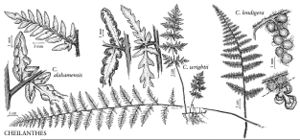Cheilanthes alabamensis
Linnaea 20: 4. 1847.
Stems short-creeping to compact, 3–7 mm diam.; scales uniformly brown or slightly darker at base, linear-lanceolate, straight to slightly contorted, loosely appressed, persistent. Leaves clustered, 6–50 cm; vernation noncircinate. Petiole black, rounded adaxially. Blade lanceolate to linear-oblong, 2-pinnate to 2-pinnate-pinnatifid at base, 1–7 cm wide; rachis rounded adaxially, lacking scales, with dimorphic pubescence, abaxially sparsely hirsute, adaxially covered with tortuous, appressed hairs. Pinnae not articulate, dark color of stalk continuing into pinna base, basal pair slightly smaller than adjacent pair, ± equilateral, appearing glabrous or sparsely pubescent adaxially. Costae green adaxially for most of length; abaxial scales absent. Ultimate segments narrowly elliptic to elongate-deltate, not beadlike, the largest 3–7 mm, abaxially and adaxially sparsely hirsute to glabrescent. False indusia marginal to obscurely inframarginal, somewhat differentiated, 0.1–0.4 mm wide. Sori ± continuous around segment margins. Sporangia containing 32 spores. n = 2n = 87, apogamous.
Habitat: Rocky slopes, cliffs, and ledges, usually on limestone
Elevation: 100–2000 m
Distribution

Ala., Ariz., Ark., Ga., Kans., Ky., La., Mo., N.Mex., N.C., Okla., Tenn., Tex., Va., Mexico.
Discussion
Plants of Cheilanthes alabamensis occurring in the flora are apogamous triploids; a sexual diploid cytotype has been found in Nuevo León, Mexico (M. D. Windham, unpublished). Given the high degree of morphologic similarity between the two cytotypes, the North American triploid probably was derived from the Mexican diploid through autopolyploidy. In the flora, Cheilanthes alabamensis is most often confused with C. microphylla, from which it is distinguished by having thicker stems, mostly green costae, and 32-spored sporangia.
Selected References
None.
